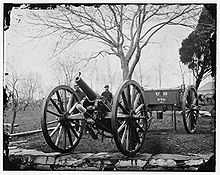Wiard rifle

The Wiard rifle is a semi-steel light artillery piece invented by Norman Wiard. About 60 were manufactured between 1861 and 1862, at O'Donnell's Foundry, New York City: "although apparently excellent weapons, [they] do not seem to have been very popular".[1]
Wiard described two calibers: a six-pounder rifle with a 2.6 inch bore and a twelve-pounder smooth bore with a 3.67 inch bore.[2]
The six-pounder's tube was 53 inches long, weighed 725 pounds and had an effective range (at 35°) of 7000 yards, with a standard powder charge of 0.75 lbs and 6 lb. Hotchkiss bolts.[1]
The Wiard rifle was cast in puddled wrought-iron (semi-steel) and was mounted in a special Wiard field carriage that was unique in its design.[3] The rim base was spaced farther apart than any diameter of the tube, permitting unrestricted rotation on the trunnions without interference from the undercarriage. Wiard altered the shape of the carriage's cheeks, relocated the axle and provided a long elevating screw; this made firing at elevation of up to 35 degrees possible.[2] It also meant that one carriage could slide beneath the next, allowing for more efficient storage and transportation.
Other innovations included a flat trail plate with a metal keel (preventing the rifle digging itself in the ground upon recoil), and a better system for braking the carriage without damaging the iron tires.[1]
References
- ↑ 1.0 1.1 1.2 Artillery Profile: 6 pdr. Wiard Rifle
- ↑ 2.0 2.1 James C. Hazlett, Edwin Olmstead, M. Hume Parks, Field Artillery Weapons of the Civil War. 2nd revised edition, University of Illinois Press, 2004. ISBN 0-252-07210-3. 322 pages
- ↑ A Primer on American Civil War Field Artillery